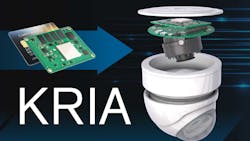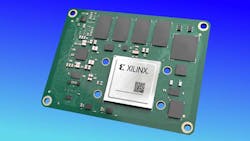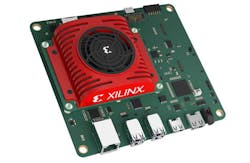Xilinx Enters FPGA System-on-Module Arena
What you’ll learn:
- What is Kria?
- Why is Xilinx moving into the FPGA SOM space?
Xilinx’s Zynq family has been an extremely successful system-on-chip (SoC) FPGA solution. However, as with many FPGA platforms, using this flexible solution can be especially tough when it comes to interfacing and power management. The new Kria system-on-module (SOM) addresses these issues by providing a standard electrical and programming environment.
Initially, Xilinx has its sights set on camera and vision systems for applications like smart cities, retail analytics, and robotics. The module is small enough to fit in the camera subsystem, bringing hardware acceleration to the edge.
The K26 COM is the first of the family (Fig. 1). This mid-range platform is built around a Zynq UltraScale+ MPSoC with a quad-core Arm Cortex-A53 subsystem. It works with a 256K system-logic-cell FPGA and an H.264/265 video codec. The K26 can deliver up to 1.4 TOPS of machine-learning/artificial-intelligence (ML/AI) acceleration.
The MPSoC has 245 I/O pins and support for up to 15 cameras with a mix of MIPI, sub-LVDS, and SLVS-EC interfaces. Four USB ports support USB 2.0 and 3.0. There are four Ethernet ports that operate at speeds of 1 to 10 Gb/s, allowing support for a single 40 Gbit/s interface. Built-in security support is compatible with IEC 62443.
The module comes with 4 GB of 64-bit DDR4 memory. There’s on-board power management and serial-boot flash memory, too. The module has a pair of 24-pin, Samtec connectors on the bottom. Even TPM is supported on commercial and industrial-grade modules.
While a useful piece of modular hardware, it’s the application infrastructure that makes a difference. Developers can get down and dirty using the Vivado Design Suite to customize the FPGA, but most developers are likely to utilize Xilinx’s Vitis open-source framework for heterogeneous programming. Vitis addresses the processor subsystem as well as the FPGA, enabling developers to utilize third-party software that addresses application and FPGA support. The additional support for Kria targets image processing (Fig. 2).
Depending on the configuration, it’s possible to change the underlying framework of one of the many applications without needing to do place-and-route required by fully custom FPGA changes. These modifications can address video codecs as well as AI/ML acceleration and processing. Vitis supports standard AI/ML models such as those generated using TensorFlow, PyTorch, and Caffe.
Xilinx has been providing Yocto-based Peta Linux support for its Zynq family. With the Kria announcement, it adds Canonical’s Ubuntu Linux, which supports Snaps, a modular software delivery system.
An App Store environment developed by Xilinx is already used with the Alveo enterprise FPGA platforms. Kria SOMs will have similar support, targeting embedded applications starting with image and video processing.
Developers can begin with the $199 Kria development kit, which includes a carrier board that exposes all of the peripheral interfaces (Fig. 3). The carrier board also has a Pmod port and microSD socket for system software. The heatsink fan is designed for overkill, allowing developers to push the limit or determine whether a more conservative cooling system would be adequate for an application.
The carrier board contains a single 1-Gb Ethernet port and four USB ports. A built-in image signal processor (ISP) has up to eight camera interfaces, including three MIPI ports. There are HDMI and DisplayPort outputs.
The starter kit is designed to get developers up and running in an afternoon. FPGA programming using Vivado may take a bit longer for the uninitiated.
Commercial C-grade units with an operating temperature range of 0 to 85°C plus a two-year warranty start at $250. The I-grade units, which operate at −40 to 100°C, come with a three-year warranty. They are priced at $350. The starter kit and modules are available now.
About the Author
William G. Wong
Senior Content Director - Electronic Design and Microwaves & RF
I am Editor of Electronic Design focusing on embedded, software, and systems. As Senior Content Director, I also manage Microwaves & RF and I work with a great team of editors to provide engineers, programmers, developers and technical managers with interesting and useful articles and videos on a regular basis. Check out our free newsletters to see the latest content.
You can send press releases for new products for possible coverage on the website. I am also interested in receiving contributed articles for publishing on our website. Use our template and send to me along with a signed release form.
Check out my blog, AltEmbedded on Electronic Design, as well as his latest articles on this site that are listed below.
You can visit my social media via these links:
- AltEmbedded on Electronic Design
- Bill Wong on Facebook
- @AltEmbedded on Twitter
- Bill Wong on LinkedIn
I earned a Bachelor of Electrical Engineering at the Georgia Institute of Technology and a Masters in Computer Science from Rutgers University. I still do a bit of programming using everything from C and C++ to Rust and Ada/SPARK. I do a bit of PHP programming for Drupal websites. I have posted a few Drupal modules.
I still get a hand on software and electronic hardware. Some of this can be found on our Kit Close-Up video series. You can also see me on many of our TechXchange Talk videos. I am interested in a range of projects from robotics to artificial intelligence.




